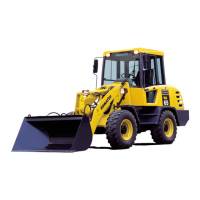MAINTENANCE BASICS
7-18
TIRES
TIRE COMPONENTS
1. Steel Cord Belt
2. Radial Carcass
3. Bead Core
4. Liner
5. Diagonal Carcass
6. Bead Cores
CHECKING THE TIRES
Particularly after work on rocky surfaces, check the tires for dam-
age, wear and tear, and fissures. Tighten loose screws and nuts.
For reasons of safety, replace the tires, if you detect one or sev-
eral of the following faults:
• The bead core (3) is torn or buckled.
• The tire is excessively worn and more than a quarter of the
carcass (5), not the liner (4), is exposed.
• The damage to the carcass (5) exceeds one third of the tire
width.
• The single plies of the tire are separated.
• Radialfissuresdowntothecarcass(5).
• Deformation or damage to such an extent that the tire can-
notbeusedanymore.
CHECKING THE TIRE PRESSURE
When checking the tire pressure, pay attention to fissures, peel-
ing, and unusual wear and tear. Remove nails, pieces of metal,
and other undesired material from the tire.
• If the tire bursts or if the parts of a rim consisting of sever-
alpartscomeapartwhilethetireisbeinginflated,partsof
the tire or rim may cause injury or damage to property!
Use a tire-inflating hose with clamping device to inflate
the tire. The hose must be long enough to ensure that you
can stand erect next to the tire's tread. Stand next to the
tire's tread when you inflate the tire. Before you inflate a
removed tire, secure it by means of ropes, chains, or a
protecting cage.
• Improper work at tires and rims may cause severe injury
or damage to property due to the high tire pressure!
Repairs at wheels and tires must only be performed by
trained experts.
The service life and performance of a tire depend very much on
the tire pressure. Only correct tire pressures will protect the tires
from damage.

